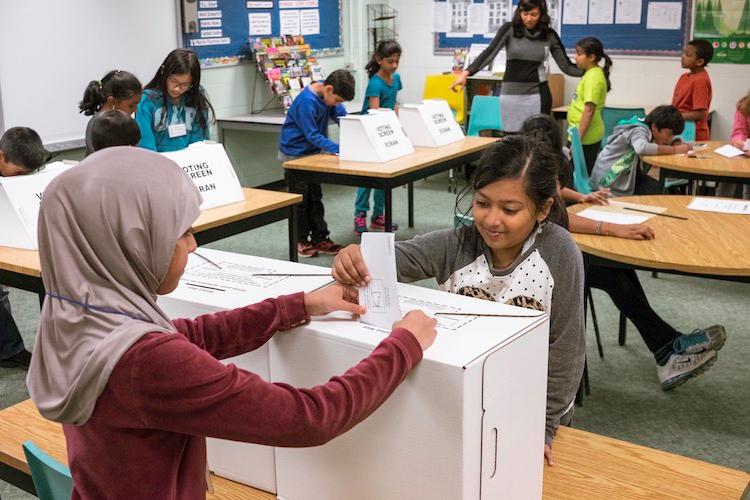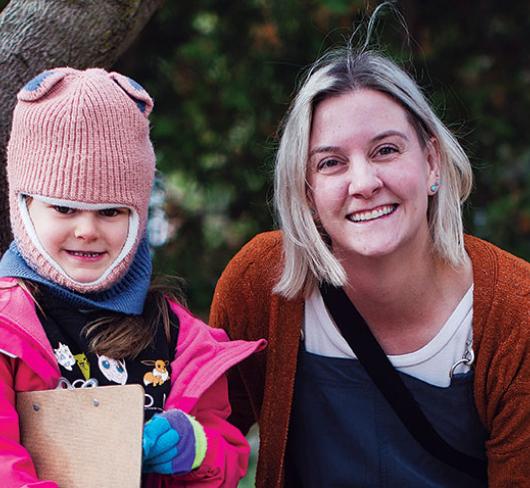
Teaching Democracy and Active Citizenship with Student Vote
Introduction by Lindsay Mazzuco
For the last 15 years, Ontario teachers have been engaging their students and their schools in a program that brings real world democracy into their classroom and helps students develop the habit of active and engaged citizenship.
Student Vote is a parallel election for students under the voting age that coincides with general elections. Students explore government and the electoral process, research the parties and platforms, discuss relevant issues with family and friends, and cast ballots for official candidates.
The vision is simple: teach kids about how to vote and why, foster their connection to the community, and eventually, reverse the decline in voter turnout.
The very first Student Vote program was delivered in conjunction with the 2003 Ontario provincial election. Coordinated by a small team and involving more than 800 teachers, the trial gave 300,000 students an opportunity to experience the voting process firsthand.
The founders have grown this program into a national civic education charity, CIVIX. In addition to delivering 38 Student Vote projects across Canada, CIVIX offers programming between elections focused on government budgets, news literacy and elected representatives, as well as professional development opportunities for teachers.
The network of teachers involved in Student Vote has grown steadily over the years. In the last federal election, more than 3,200 Ontario teachers registered their schools to participate and another 6,000 Ontario teachers implemented the program. The commitment of these teachers is truly remarkable and inspiring.
An independent evaluation commissioned by Elections Canada in 2015 found that Student Vote had a positive impact on student knowledge and understanding of Canadian politics and elections as well as on student interest and confidence in discussing politics and future voting intentions.
As recent events around the world have shown, democracy is fragile and cannot be taken for granted. A healthy and robust democracy demands an educated, informed and committed citizenry that understands the value of our political system, and how to act within it.
Ontario will have three elections within three school years, beginning with the provincial election this spring. We asked eight teachers why they are involved with Student Vote. Here is what they said:
Developing Critical Thinking Skills
Serena Yoon, Peel Teacher Local
Voting is extremely important and people too often do not know why they are voting for a candidate. I like how Student Vote allows students to examine the issues presented by the parties and through the media as they happen. Students learn by doing. Through the study of party platforms and candidate ads, students can react, analyze and draw their own conclusions. When students can articulate their own reasons for supporting an issue, they are demonstrating the ability to use critical thinking skills and choose the candidate who will best represent their wishes. As a bonus, their interest in the election can spark discussions at home and help parents decide what is important to them as well.
Excitement Of Voting Day
Kim Davidson, Elementary Teachers of Toronto
In this information age, especially with the advent of ‘fake news,’ it is more important than ever to provide students with the opportunity to develop critical thinking skills. The activities and lesson plans developed by CIVIX allow students to practice these skills in a real-world setting. My favourite part is always the excitement of Student Vote day – students feel mature and empowered. Participating in Student Vote is also an easy way to get parents involved with student learning. I’ve had a number of students tell me over the years that the program gave them the voice to encourage their parents to go out and vote.
For the upcoming provincial election, my plan is to make Student Vote the culminating activity in a larger inquiry-based Social Studies unit of study, which I will be co-teaching with grades 5 and 6 teachers. The unit will focus on the role of government in our community, as well as investigate the influence of media on political points of view (I also teach media literacy). I am new at my school so I will run the program with just a few classes this year, with the goal of growing it to a whole school activity in future elections.
Sharing What Students Have Learned At Home
Chris Brouillard-Coyle, Greater Essex Teacher Local
The best part of Student Vote in my experience is when students actually vote and the results are shared. Students like to see how their votes compare with those from other schools, as well as how their votes matched up with the voters in Canada.
I plan on working through the entire Student Vote resource for the upcoming provincial election. The activities are a great way to get students involved and interested in learning about democracy and the important role of citizens. Ideally, they will then share what they’ve learned with their parents, and perhaps be able to encourage others to take on a more active role in the democratic process that is a pillar of our country.
Learning The Responsibilities That Come With The Right To Vote
Alisha Mohammed, Elementary Teachers of Toronto
Student Vote allows students to learn about the responsibilities that come with the right to vote. I participate because it’s an experience that brings the real world into the classroom. The best part of Student Vote is watching students become excited about what they’re learning. They follow and engage in campaigns, think critically about what the candidates are promising and learn about the issues affecting their own neighbourhoods within the context of the province. It makes the study of government a truly authentic experience.
For the upcoming election, we will be doing a variety of activities, including classroom learning about the levels of government with a focus on the provincial level, community walks to observe the impact of media (collateral) on the campaign, research and presentations of party platforms to junior classes by intermediate students, a student-led media campaign to advertise the importance of voting and student debates on important party platform issues. We will also be inviting the local candidates into our school so students can meet them and ask questions, and bringing in local community members to talk about the importance of voting.
Hosting Local Candidates At Our School
Kim Stenhouse, Waterloo Region Teacher Local
Student Vote is one of the best ways I know to incorporate the elements of the Citizenship Education Framework of the Revised Social Studies/History/Geography Curriculum (2013) into my teaching. A real experience such as Student Vote helps these lessons “stick.”
I am looking forward to using the Student Vote resources and activities to make the election more real and accessible for my students. From learning about the political parties to how debates are structured and how to mark a ballot, it is all valuable and important! This year I also hope to host the local candidates at our school. The culmination of it all is the actual Student Vote Day, which demonstrates democracy in action. We try to make it as much like the “real thing” as possible. I know that these early experiences in civic engagement will help grow a generation that knows what it means to be responsible, active citizens, both their privilege and responsibility as Canadians.
Political Conversations Where You Least Expect Them
Shaun Kruger, Trillium Lakelands Teacher Local
Student Vote creates meaningful, and sometimes difficult, dialogue in the classroom, in the school and even at home. The best part is how kids become engaged in current issues and see the political conversations continue beyond the classroom, especially where it’s least expected, such as on the playground or in the school hallways.
In the past, I’ve had my students randomly draw which party they will research and role play. Each group choses a party leader to represent them who gives a speech or even participates in a debate for other classes in the school. The rest of their group supports them with research and talking with others to support their party and its platform. Come voting day it is always fun to see who comes out on top in the school and in the riding and who wins the election as a whole. It also creates great discussion afterward as to why each of those outcomes may have occurred.
Demystifies The Election
Heather Earle, Upper Canada Teacher Local
Student Vote demystifies the election and voting process. The resources and support provided authenticate the experience for student voters – pre- to post-election – and help them realize they are part of a larger collective of young people who are on the road to owning their democracy.
The new sports dome opening soon in our riding will be the starting point for our discussion this year as students explore how it took collaboration among all levels of government and local residents to make this facility a reality for the community. In addition to providing a relevant framework for the nuts and bolts of studying government, the resources will facilitate students’ understanding of how provincial politics play a role in our daily lives. We also plan to invite candidates to a forum to introduce themselves and answer students’ questions, and use the news literacy tools that CIVIX is developing.
Students Become Agents Of Hope
Stephen Skoutajan, Ottawa Carleton Teacher Local
Student Vote embeds political engagement into learning not just as an acknowledged right but also as an obligation and an invitation for young people to participate in our democracy. It allows them to see themselves reflected in the process as agents of hope and change. One of the leading causes of anxiety and depression in youth is their inability to see how they fit into the world around them. Student Vote invites my students into their democracy in a very real way.
We will be organizing neighbourhood walks where we can reach out to local businesses and organizations and learn about the issues that are at stake for them in the upcoming provincial election. This will set us up well for an all-candidate meeting where we can address the issues directly. My students don’t understand why so many Canadians fail to show up at the polls and I’m sure they will be floating ideas about how to increase voter engagement by reaching out to members of our neighbourhood and to young voters on college and university campuses. In the end, Student Vote brings together all our learning into one culminating event that celebrates the act of marking a ballot.
Conclusion
The Student Vote program involves four key steps:
- Register your school: The program is open to all schools, focused on grades 4 through 12. There is no cost to participate.
- Receive materials: Registered schools are supplied with print and online pedagogical materials, an election manual, electoral district maps, campaign posters, ballots and ballot boxes.
- Engage with the campaign: The activities are intended to inform students about government and the electoral process, encourage research into the candidates, parties and issues and foster dialogue among students and their families.
- Student Vote Day: Students take on the roles of deputy returning officers and poll clerks and coordinate an authentic vote for their peers. The results are announced by media after the close of the official polls.
More than 2,000 schools are expected to participate in the Student Vote program for the 2018 Ontario provincial election.
For more information visit: www.studentvote.ca.
